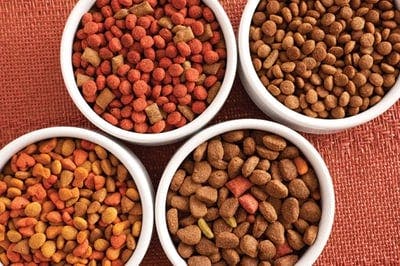
Dog Feeding Guide: The 5 Nutrients To Look For When Buying Dog Food
Health and Wellbeing
Dog
Diet and Nutrition
01/05/2023
There are five essential nutrients dogs need to eat; water, protein, fat, carbohydrates, minerals, and vitamins. Each of these nutrients plays its part in supporting your dog’s basic functions to thrive, so it is important you choose a dog food that is nourishing and balanced. But with so many different dog food options out there, how could you possibly know what the healthiest dog food is or what dog food is right for your dog?
Before we dive into how to find the right dog food, let’s take a look at how your dog’s body works, the 5 key nutrients that support your dog to live a long and healthy life, and what to look for when reading dog food labels.
What Are The Nutritional Needs Of A Dog?
1. Protein
Protein is a very important part of healthy and balanced dog food because all your pet’s body tissues are made of proteins. Your dog's body makes only 13 of the 23 amino acids that are the building blocks of proteins. The other 10 have to come from food. So it’s vital to make sure your dog is getting enough protein through its diet. Be sure to look for dog foods with natural, high-quality proteins as the first ingredient. Protein can come in many ingredient forms including fish, meat, or poultry. It is up to your dog’s personal taste preferences and any other specific dietary needs the protein source may provide. Generally speaking, adult dogs need between 18% to 29% protein in their food, whereas growing puppies at least 22% protein to support healthy growth and development.
2. Fats and oils
Fats are a necessary part of a balanced diet for dogs. They provide a concentrated form of energy, giving your dog more than twice the amount of energy than carbohydrates and proteins. Generally, adult dogs need 12-20% of fat in their diet to maintain a healthy weight. The fat content listed on a typical bag of dog food comes from multiple ingredient sources such as; animal, vegetable oils, and things like cereal grains. Though beware there is of course too much of a good thing and a high-fat diet can cause your pet to become overweight and have other complications. Make sure you adjust your dog's fat intake based on their breed, life stage, body condition, and activity level. To see what fats are contained in your dog’s food, look out on the ingredients list for animal fat, corn oil, vegetable oil, sunflower oil, fish meal, fish oils, and flaxseed (linseed)

Dog food
3. Carbohydrates
It is essential to incorporate carbohydrates in your dog’s diet because it supplies them with energy as well as being the main source of dietary fiber. The body craves glucose, and if it is not available with carbohydrates, then it will take amino acids away from other processes in the body. As a general guideline growing animals and dogs that have high-energy needs should be fed a diet with at least 20% carbohydrates. The common sources of carbohydrates in dog food include ingredients such as whole wheat, potato, legumes, oatmeal, corn, brown rice, buckwheat, barley, and quinoa. Although there has been no minimum requirement of carbohydrates set by AAFCO.
4. Vitamins and Minerals
The vitamins & minerals in a dog’s diet support many of their body functions to perform at their best, such as the creation of DNA, bone development, eye function, and brain function. Your dog can get all the vitamins and minerals they need in complete and balanced dog food, including:
- Vitamin A
- Vitamin D
- Vitamin E
- Vitamin K
- B-complex vitamins
- Calcium
- Phosphorus
5. Water
Water makes up 70 to 80 percent of a mature dog’s body mass and is considered the most important nutrient for your dog because of the vital role it plays in your dog’s body functioning. Without water, your dog’s body cannot transport nutrients, digest nutrients for energy, regulate temperature, or eliminate waste. Water helps break down carbohydrates, proteins, and fats as well as lubricating joints. Dogs get water through their diet and by simply drinking water. As a general rule, dry dog food normally has around 10% moisture, while wet dog food can be around 80%. Although no matter what your dog eats it is extremely important to always provide your dog with a fresh supply of water.
AAFCO Pet Food Standards
AAFCO (Association of American Feed Control Officials) is an organisation that sets the standards for pet food. In order for dog food to be marketed as “complete and balanced”, it must meet the nutritional standards established by AAFCO. The AAFCO statement found on pet food packaging explains whether the food contains essential nutrients, how that was determined, and for which life stage the food is appropriate. They separate life stages into two categories; adult maintenance and growth and reproduction which are foods designed for growing puppies/kittens and pregnant or lactating females.
**Bear in mind every dog is different, so it’s important to adjust their diet and the nutrition they are eating according to their age, weight, activity levels, and any special dietary requirements. Talk to your vet about specific diet and nutrition recommendations for your dog. **
**
Now that you better understand the key nutrients dogs need to eat to maintain a balanced diet hopefully it is less daunting choosing the right dog food to help your dog live a long and healthy life. **